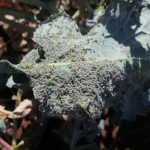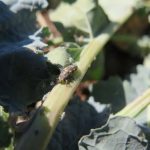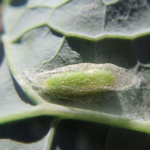While drought has dashed the planned rotations of many growers, there is still a risk of pest outbreaks at this time of year. Below are some of the most common to keep an eye out for.
A note on withholding periods following insecticide use in crops that are diverted to stock
If insecticide treatments have been applied to crops which are later used for feeding animals, withholding periods apply to both grazing and cutting. Be aware that WHPs can vary widely between products, and even within product groups, and that records of pesticide use in crops prior to cutting may be requested by the hay buyer. Check out our recent Beatsheet article for more information.
On this page:
Wheat and barley
Armyworm
Barley in particular is seeing high numbers of armyworm in some areas. For more information, see the recent Beatsheet article ‘Armyworm outbreak’.
Mites
In July there were a number of reports of blue oat mite (BOM) in crops, still causing silvering/greying of the foliage.
There have not been any reports of brown wheat mite (BWM; Petrobia latens), so far this season. BWM is more common in warm, dry springs when their feeding can give the crop a silvery sheen and browning on leaf tips. BWM is smaller than BOM (0.6 vs 1.0 mm), and quite difficult to see in the crop unless in very high densities. A hand lens or macro lens for your phone can be useful in confirming the identification. A key feature of BWM is the long front legs.
If BWM treatment is considered necessary, keep in mind that related Bryobia species are known to be more tolerant to these products than BOM. There is no established threshold for BWM; the decision to treat is made on the progression of the leaf damage, particularly if it affects the upper leaves post head emergence.

Brown wheat mite (left), and BWM feeding on the underside of a leaf (right). The feeding damage caused (removing cell contents) is very evident on this leaf.
See cesar’s PestNotes series for more information on the individual mite species.
Russian wheat aphid
Keep an eye out for Russian wheat aphid (RWA), or any unusual aphids when checking cereals. The most northerly detection of RWA is still Coonabarabran (2018), with a small population found again this season on the Liverpool Plains. There is no record of RWA in Queensland, and any suspicion that these aphids are in wheat or barley in the Northern Region should be followed up with DAF (Melina Miles 0407 113 306) or NSW DPI (Zorica Duric 0409 927 226).
Look for symptoms on plants, and then look for aphids on the affected tillers. RWA can be distinguished from the oat, corn and rose grain aphids by the absence of siphunculi (exhaust pipes at the rear), the presence of a double cauda (tail), and short antennae.
See GRDC’s RWA factsheet for more information on this pest.
Faba bean
Green mirids
Green mirids (GM) will cause spotting on the seed coat if they feed on seed as it matures in the pod. In faba beans, there is no evidence (dark wet spots, wartiness, and discolouration) evident on the pods or the seed coat whilst the seed is still green. The spotting only appears as the seed coat colours (as the seed dries). Exposing filling pods to green mirids resulted in seed that didn’t fill. It is clear that mirids can impact on both grain quality and yield, depending on the stage of the crop when they are present. As with mungbeans and cotton, late instar nymphs are as damaging as adults.
Although this trial work has clearly established the link between GM and damage in faba beans, we have not yet established a threshold for either quality or yield loss. The current ‘rule of thumb’ is based on the anecdotal observation of agronomists on what density of GM resulted in grain that was discounted for spotting. Reports suggest that densities over 5 GM/m row (beat sheet sampling) were more likely to have significant spotting.
DAF’s trials this season will examine the relationship between GM density and resultant damage.
Armyworm
In previous seasons with high armyworm activity, like we are seeing this season, there have been reports of armyworm larvae in faba beans. These are not the armyworm that occurs in wheat and barley (Mythimna species), they are Spodoptera exigua (lesser armyworm). You might be familiar with this group of armyworms from seeing the related Spodoptera litura larvae in cotton, commonly known as cluster caterpillars.

This photograph of Spodoptera exigua damage in faba beans (and the larvae above) were taken in 2014. The defoliation was relatively minor as the Spodoptera numbers were low.
Canola
Aphids
Aphids tend to be abundant in moisture-stressed canola crops, despite the activity of natural enemies. There are reports of recent pirimicarb treatments being ineffective, which indicates that the densities were either so high that there was significant survival, or that there is a high proportion of the insecticide-resistant green peach aphid (GPA) present.
GPA populations are resistant to carbamates (Group 1A, e.g. pirimicarb), synthetic pyrethroids (Group 3A) and organophosphates (Group 1B), with high levels of resistance to carbamates and synthetic pyrethroids widespread. Moderate resistance to organophosphates is present in many populations, and resistance to neonicitinoids (Group 4A) is emerging. If you intend to treat an infestation of GPA, consult the GPA resistance management strategy for your area to avoid control failures.
For more information on GPA, consult GRDC’s GPA factsheet.
In the northern regions, GPA and turnip aphid tend to colonise the lower leaves and populations typically decline as temperatures warm up. It is the cabbage aphid that tends to predominate through late winter and spring on the terminals and the podding racemes. Cabbage aphid can also occur in high densities on the leaves, particularly prior to bolting. There is a suite of natural enemies that will attack aphids in canola (and other crops), including the fungal disease and ladybird beetle larva shown here.
- High density cabbage aphid population on the underside of a canola leaf.
- Aphid with fungal symptoms
- Ladybird larva on canola
Diamondback moth and cabbage white butterfly
When sweeping or beating canola, you are likely to come across both diamondback moth (DBM) and cabbage white butterfly (CWB), but these species rarely cause significant damage in Northern Region crops. CWB feed on leaves low in the canopy, and are particularly susceptible to parasitism. DBM populations can build up to damaging levels where larvae can defoliate plants and damage pods.
| Table: DBM threshold guidelines by crop stage developed in South Australia (SARDI) | ||
| Crop stage | Moisture stress | DBM larvae threshold |
| Pre-flowering | Y | 30 per 10 sweeps |
| N | 50 per 10 sweeps | |
| Early to mid-flowering* | N | >50 per 10 sweeps |
| Mid to late-flowering* | N | >100 per 10 sweeps |
| Pod maturation* | N | 200 per 10 sweeps |
| *Moisture stress not listed for these growth stages because moisture-stressed crops are more susceptible to insect damage. A lower threshold may be used if extended dry periods are expected. | ||
DBM is another pest that has developed resistance to several insecticides, including synthetic pyrethroids and organophosphates. In the event that a DBM infestation exceeds threshold, refer to the GRDC factsheet on DBM resistance management for guidance.
- Diamondback moth larva
- Diamondback moth pupa
- Diamondback moth adult
- Cabbage white butterfly larva
- End result of parasitism of a CWB larva by Cotesia sp.












